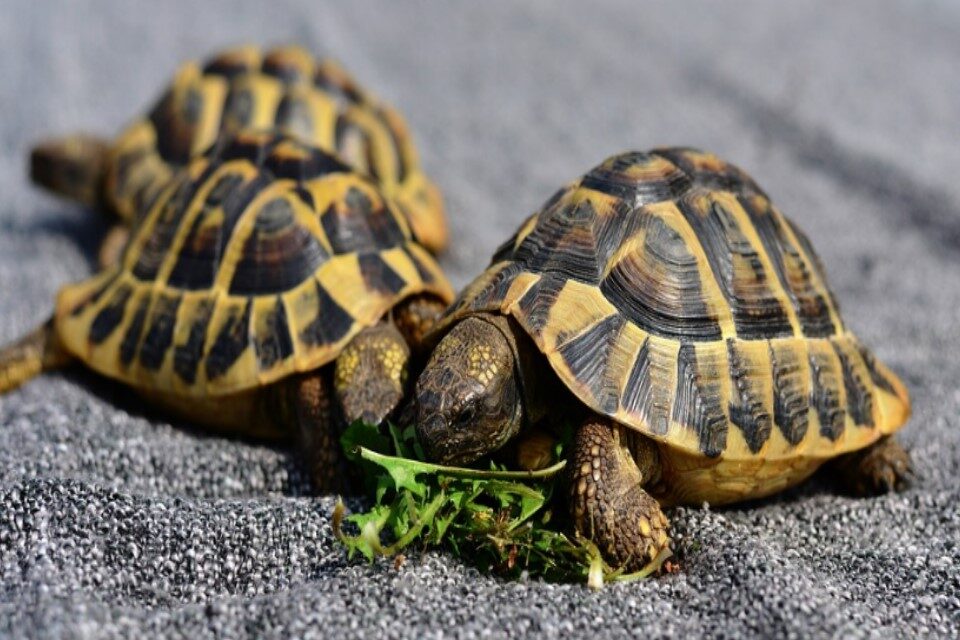Food is an essential part of your turtle’s life. Keeping a good diet strengthens its immune system, meets all its needs and, inevitably, allows it to live everyday life without health concerns. So what do you need to give it on a daily basis?
What does it need? What should I avoid? We will enlighten you on these specific points.
What does a turtle eat
Your turtle is an herbivorous reptile. However, in the wild it is more opportunistic and spends its time eating whatever it can find. It, therefore, happens to feed on small insects. In captivity, the ideal is to compose a menu that is both varied and precise.
It should consist of 90% vegetables and only 10% fruit. Forget about all proteins of animal origin. Their digestive system will not accept meat food. Either way, it doesn’t need it to meet its nutritional needs.
Above all, in captivity, your turtle will tend to exercise much less energy than in nature, where it is constantly looking for something to eat. In fact, there is no need to feed it in such a large amount. In addition, like the iguana or the lizard, its calcium requirements are 1.5 to 2 times greater than those for phosphorus. This contributes to the solidification of his bones.
Vegetables
It is the basis of your turtle’s diet. Vegetables allow it to have a high fiber intake. Thus, plants such as dandelion, clover, watercress, plantain, nasturtium, lamb’s lettuce or Alfalfa are excellent for
its health. To that, there is a whole bunch of foods that it can eat without worry. In detail: mauve, bindweed, but also sedum.
We can also mention the following plants: vetch, sainfoin and Cardamine. Curly chicory and turnip greens are also good for it, as are radish tops, althea flowers, Bignone flowers, hollyhock and snapdragon flowers, but also nasturtium flowers.
Turtles are fond of vegetables such as zucchini, endives, spinach, beets and celery.
The secret to good nutrition is to vary your pleasures. Of course, it should not have the same foods under its nose every day; otherwise, it might get bored. But, as in nature, do not hesitate to change its menu a little every day.
The fruits
They should accompany your turtle’s meals. Do not give it every time but for example once in 3 or 4 meals. It particularly appreciates the following fruits: strawberry, raspberry, blackberry, apples, pears, bananas, mango, grapes, star fruit, raisins, peaches, tomato, guava, kiwis, and melons.
Vitamin
To avoid the development of deficiencies, it is recommended to introduce, once a week, a Vitamin/calcium supplement in your meal. The supplement, offered in the form of a powder, ensures a balanced ratio. It needs to be scattered on fruits or vegetables or in tiny granules. And that will solidify its shell, thus being able to receive the rays of the sun better.
Granules
They are to be avoided most of the time. However, it is a backup food that should only be used in an emergency. Or, it can be used to feed your turtle when it is still young, in its terrarium, before taking it outside. Good food also if your turtle is sick or when it comes out of Hibernation.
Other foods to be avoided
Many foods are prohibited in the diet of your turtle. This is because they are dangerous or poisonous. Thus, the list is not exhaustive and includes mahogany, amaryllis, avocado, chervil, hemp, cypress, lyre fig, mistletoe, holly, hyacinth, daffodil, jasmine, oleander, lily, lupine, mandrake, mimosa, lily of the valley, narcissus, marigold, wild sorrel, rosemary or even sage, tobacco and tulip. Note that lettuce causes kidney problems. Therefore, it should not be given.
Conclusion
The diet of your herbivorous turtle is 90% vegetables and 10% fruit. It should be Supplemented once a week with a vitamin and calcium supplement, which you sprinkle on food. In addition, pellets can be given, especially when your reptile is sick or young. Always favor fresh food.
